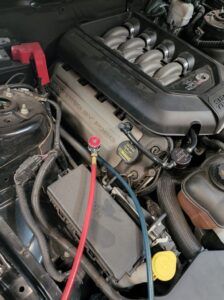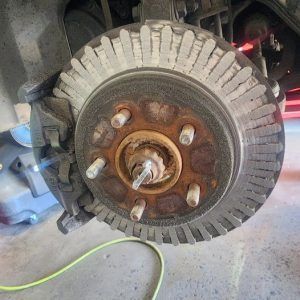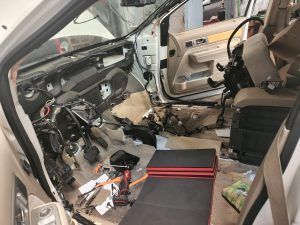A Look At The Different Types Of Brake Pads And Their Uses
When it comes to driving, one of the most important safety features of any vehicle is the brakes. And within the brakes, one of the most crucial components are the brake pads. These small but mighty parts are responsible for creating the friction necessary to slow down or stop your vehicle.
But did you know that there are different types of brake pads available, each with their own advantages and disadvantages? In this article, we will take a look at the different types of brake pads and their uses, so that you can make an informed decision when it comes to choosing the right brake pads for your vehicle.
First, let’s talk about the importance of brake pads. Brake pads are what allow your vehicle to slow down or stop when you apply the brakes. They work by creating friction against the brake rotor, which in turn slows down or stops the rotation of the wheels. Without brake pads, your vehicle would not be able to stop quickly or safely.
It is therefore important to ensure that your brake pads are in good condition and functioning properly at all times. And when it comes to choosing the right brake pads for your vehicle, there are several factors to consider.
Key Takeaways
– Different types of brake pads are available, including ceramic, metallic, and organic, each with their own advantages and disadvantages.
– Factors to consider when selecting brake pads include individual needs, noise and dust, cost, compatibility, driving conditions, and environmental impact.
– Warning signs for brake pad replacement include high-pitched squealing noise, vibrating brake pedal, longer stopping distance, and dashboard warning light.
– Choosing the right brake pad is crucial for safety and performance, and proper maintenance and replacement is important for longevity.
Overview of Brake Pads and their Importance
You may not realize it, but brake pads are one of the most important parts of your vehicle’s braking system. They are the components that press against the rotors to slow down or stop your car. That’s why it’s essential to have the right type of brake pads for your vehicle.
Brake pads come in various materials, including ceramic, metallic, and organic. Each type has its unique characteristics and benefits. The brake pad material you choose can affect the performance of your vehicle’s brakes.
Ceramic brake pads are ideal for daily driving because they generate less dust and noise, are durable, and provide excellent stopping power. Metallic brake pads are suitable for high-performance vehicles because they can handle high temperatures and provide consistent braking power. Organic brake pads are the most affordable but wear out faster and generate more dust and noise.
Manufacturers use various construction techniques to make brake pads. The most common methods include molding, bonding, and riveting. Molding involves heating the brake pad material and pressing it into a mold to create the desired shape. Bonding involves attaching the brake pad material to a metal backing using adhesive. Riveting involves attaching the brake pad material to a metal backing using rivets. Each technique has its pros and cons, and your choice may depend on your driving needs and budget.
Now that you know the importance of brake pads and the different materials and construction techniques used to make them, it’s time to explore the various types of brake pads available in the market.
Different Types of Brake Pads
When it comes to brake pads, you have three main options: metallic, ceramic, and organic.
Metallic brake pads are the most common and offer excellent performance and durability.
Ceramic brake pads are a newer option that provide superior stopping power and less noise, but they can be more expensive.
Organic brake pads are the most affordable option and are made of materials like rubber, glass, and Kevlar. However, they may not last as long as the other two types.
Metallic Brake Pads
If you’re looking for brake pads that offer high performance and durability, metallic brake pads are a great option. These brake pads are made of a combination of metallic fibers, resins, and fillers, which make them highly resistant to wear and tear. They also have a higher coefficient of friction than other types of brake pads, which means they can generate more stopping power and reduce stopping distance.
One of the main benefits of metallic brake pads is their ability to perform well in high-temperature conditions. They’re less likely to fade or lose their stopping power when exposed to high heat, making them ideal for heavy-duty applications such as towing or racing.
However, metallic brake pads are also known for producing more noise and dust than other types of brake pads, which can be a concern for some drivers. If you’re looking for a quieter and cleaner option, ceramic brake pads may be a better choice for you.
Moving on to ceramic brake pads, these brake pads are known for their noise-reducing and low-dust properties.
Ceramic Brake Pads
Switching to ceramic brake pads can provide a quieter and cleaner braking experience due to their unique composition. Ceramic brake pads are made up of a mix of ceramic fibers and non-ferrous metal filaments that are bonded together with a resin compound. This composition allows for increased heat resistance, which translates to a longer lifespan for the brake pads.
Ceramic brake pads are also less likely to produce brake dust, which can accumulate on wheels and create unsightly blemishes. Additionally, they offer improved stopping power compared to organic brake pads, especially in high-speed situations.
The downside, however, is that ceramic brake pads can be more expensive than other types of brake pads. But if you prioritize longevity and heat resistance, ceramic brake pads may be the best option for you.
In the next section, we’ll take a look at organic brake pads and their advantages and disadvantages.
Organic Brake Pads
Organic brake pads offer a softer and more gradual braking experience compared to other types of brake pads. This is due to their composition, which consists of organic materials such as rubber, glass, and Kevlar fibers. The materials used in organic brake pads allow for a quieter and smoother braking experience, making them a popular choice for daily drivers.
One of the benefits of using organic brake pads is their ability to produce less dust compared to other types, such as metallic brake pads. This makes them a great option for those who want to keep their wheels clean and shiny. However, organic brake pads tend to wear out faster than other types, which means they may need to be replaced more frequently.
Overall, when considering which type of brake pad to use, it is important to weigh the benefits and drawbacks of each to make the best decision for your driving needs.
As you move into the next section about the pros and cons of each type of brake pad, it is important to consider the specific benefits and drawbacks of organic brake pads. While they offer a smoother and quieter braking experience and produce less dust, they may need to be replaced more frequently. Keep these factors in mind as you weigh the pros and cons of other types of brake pads.
Pros and Cons of Each Type of Brake Pad
As you consider the different types of brake pads available, it’s important to weigh the pros and cons of each option.
When it comes to performance and durability, ceramic brake pads are often a top choice due to their ability to handle high temperatures and last longer than other types. However, they can be noisy and produce more dust than other options, which may be a concern for some drivers.
On the other hand, organic brake pads are quieter and produce less dust, but they may not last as long and can be less effective in extreme conditions.
Ultimately, your decision may come down to cost, with some types of brake pads being more expensive than others.
Performance and Durability
For drivers who demand both high performance and long-lasting durability, there are brake pads specifically designed to handle the demands of aggressive driving without sacrificing longevity. These high performance brake pads are usually made of ceramic or semi-metallic materials that have undergone rigorous performance testing to ensure their ability to withstand repeated high-speed stops.
They are also known for their environmental impact, as they produce less dust and noise compared to other types of brake pads. In addition to their performance and durability, high performance brake pads also offer better stopping power and improved heat dissipation, making them a popular choice for sports cars and other high-performance vehicles.
However, they tend to be more expensive than other types of brake pads, and may not be ideal for everyday driving. The next section will delve into the issue of noise and dust and how it affects brake pad selection.
Noise and Dust
When selecting brake pads, it’s important to consider the issue of noise and dust and how it can impact your driving experience. Here are some things to keep in mind:
– Reducing noise: Some brake pads are designed to minimize noise, which can be especially beneficial for those who do a lot of city driving. Look for brake pads with a soft material on the surface, as these tend to make less noise than harder pads.
– Minimizing dust: Brake dust can be unsightly and difficult to clean, so many drivers prefer brake pads that produce less of it. Ceramic brake pads are a good option for those who want to minimize dust, as they tend to produce less of it than other types of pads.
Overall, it’s important to consider your individual needs when selecting brake pads. If noise and dust are major concerns for you, be sure to choose pads that are designed with those issues in mind.
Next, let’s take a closer look at cost and how it factors into your decision-making process.
Cost
Consider your budget carefully when selecting brake pads to ensure that you get the best value for your money. While cheaper options may seem like a good idea, they may not provide the same level of performance and durability as more expensive options.
In order to make a cost analysis, it’s important to consider the frequency of brake pad replacements, as well as the driving conditions in which the vehicle will be used. There are a variety of budget options available for brake pads, ranging from organic to ceramic to metallic.
Organic brake pads are typically the least expensive, but may not last as long and may produce more dust and noise than other options. Ceramic brake pads are more durable and produce less dust and noise, but are often more expensive. Metallic brake pads are the most durable and are often used in high performance vehicles, but may produce more noise and dust than other options.
Ultimately, the cost of the brake pads will depend on the specific needs of the driver and the vehicle. When choosing the right brake pad for your needs, it’s important to consider not only cost, but also performance, durability, and compatibility with your vehicle.
By taking the time to research and analyze your options, you can ensure that you make the best decision for your budget and driving needs.
Choosing the Right Brake Pad for Your Needs
Picking the perfect brake pad for your vehicle is like selecting the right pair of shoes for a long hike – it’s crucial for safety and performance. When choosing a brake pad, compatibility concerns should be the first thing on your mind.
Different brake pads are designed for different types of vehicles, so make sure you get the right one for your car. Additionally, some brake pads are designed specifically for certain temperatures, so take this into account as well.
Environmental impact is another factor to consider when choosing a brake pad. Some brake pads contain materials that are harmful to the environment, such as asbestos. If you’re concerned about the environmental impact of your vehicle, look for brake pads that are made with environmentally friendly materials.
Not only will this be better for the planet, but it can also help improve the performance of your brake pads. When it comes to choosing the right brake pad, it’s important to consider both compatibility and environmental impact.
By doing so, you can ensure that your brakes will perform at their best while also being mindful of the environment. And once you’ve chosen the right brake pads, make sure to take care of them properly to ensure they last as long as possible. We’ll discuss maintenance and replacement of brake pads in the next section.
Maintenance and Replacement of Brake Pads
Now that you’ve learned how to choose the right brake pad for your needs, it’s important to know how to maintain and replace them.
Brake pads have a lifespan, and it’s crucial to replace them before they become too worn down or damaged. The lifespan of a brake pad is determined by multiple factors, such as the type of pad, the frequency of use, and the driving conditions. Typically, brake pads can last anywhere from 30,000 to 70,000 miles, but it’s essential to regularly inspect them for wear and tear.
When it’s time to replace your brake pads, there are a few warning signs to look out for. One of the most common is a high-pitched squealing noise when you apply the brakes. This noise is caused by the wear indicator, which is a small piece of metal that rubs against the rotor when the pad becomes too thin. Other signs include a vibrating brake pedal, a longer stopping distance, and a dashboard warning light.
By paying attention to these warning signs and following the manufacturer’s recommendations, you can ensure the safety and longevity of your brake pads.
Frequently Asked Questions
How long do brake pads typically last before needing replacement?
Your brake pads’ lifespan depends on various factors, such as your driving style, environment, and brake pad quality. However, most brake pads last around 30,000 to 70,000 miles before the wear indicators show up. Regular brake pad maintenance and inspection can prolong their lifespan.
Can different types of brake pads be used on the same vehicle?
When considering different brake pads, compatibility concerns arise. Some pads may be more cost-effective than others, but using the wrong type could cause damage. Always consult a mechanic before switching pad types.
Are there any environmental concerns related to the disposal of used brake pads?
When it comes to disposing of used brake pads, there are recycling options available. This is important because brake pads contain harmful materials that can have negative environmental impacts. Proper disposal is crucial to minimize these effects.
Are ceramic brake pads always the best option for high-performance vehicles?
When considering high-performance vehicles, ceramic brake pads have pros and cons. They offer improved stopping power and less brake dust, but can be noisy and wear down rotors more quickly. Performance comparison with other types is recommended.
Is it necessary to replace all four brake pads at once, or can they be replaced individually?
When replacing brake pads, it’s not always necessary to replace all four at once. However, for cost effectiveness and safety precautions, it’s recommended to replace them in pairs. Always follow manufacturer recommendations.
Conclusion
Congratulations! You now have a good understanding of the different types of brake pads and their uses.
Brake pads are crucial components of any vehicle’s braking system, and they play a significant role in ensuring your safety on the road.
As we’ve discussed, there are several types of brake pads available in the market, each with its unique set of pros and cons. Knowing the differences between the types of brake pads can help you make an informed decision when choosing the right one for your needs.
Remember, selecting the right brake pad depends on several factors such as your driving style, the type of vehicle you own, and the driving conditions you typically encounter.
Don’t forget to perform regular maintenance and replace your brake pads as needed to keep your vehicle’s braking system functioning at its best. By doing so, you can enjoy a safe and comfortable driving experience for years to come.







